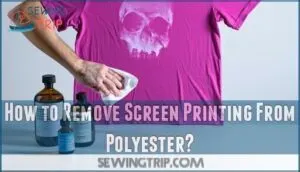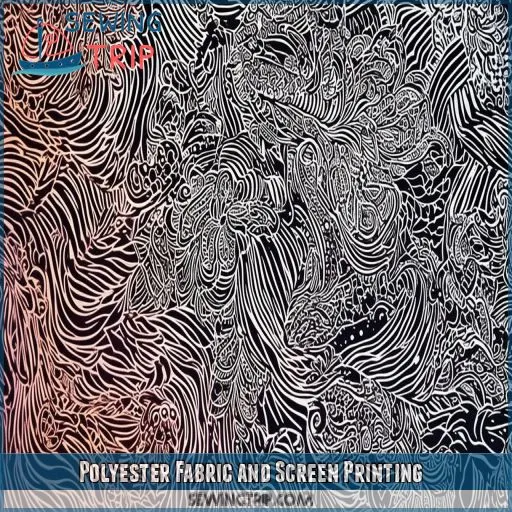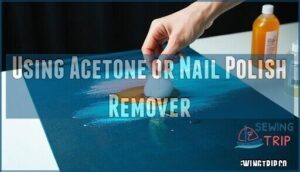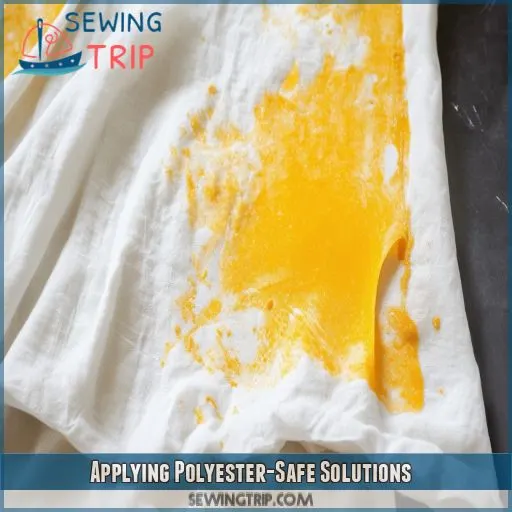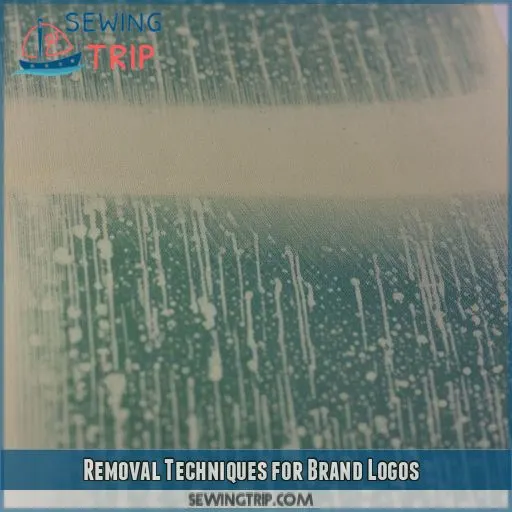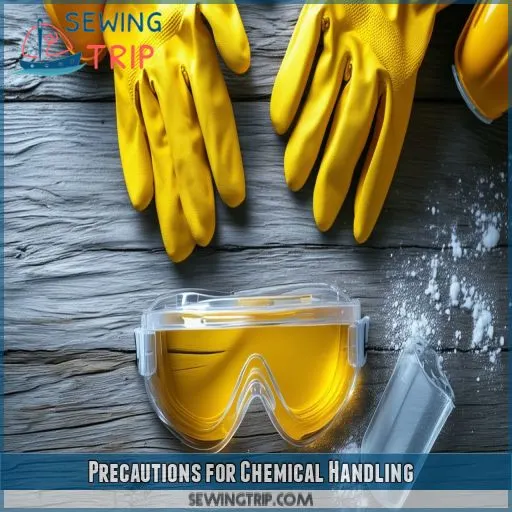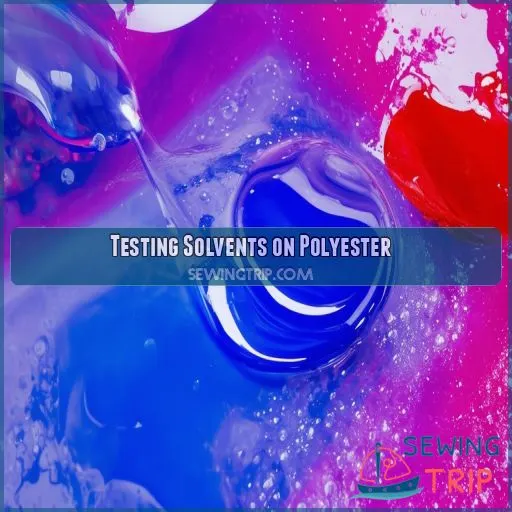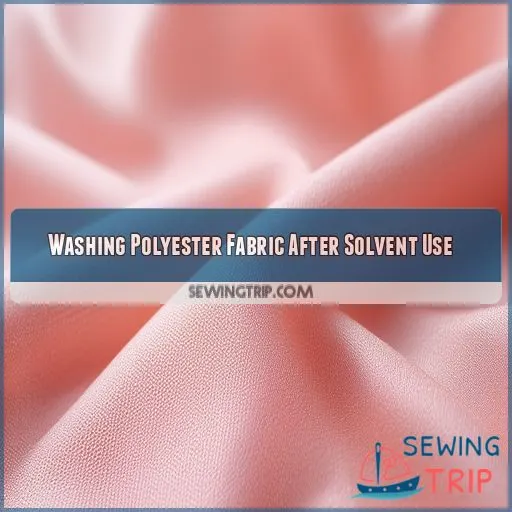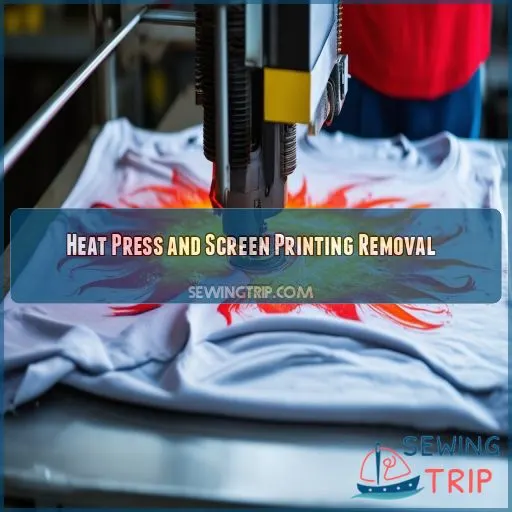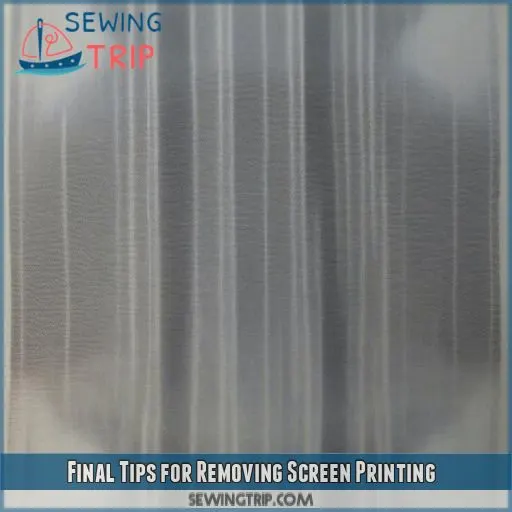This site is supported by our readers. We may earn a commission, at no cost to you, if you purchase through links.
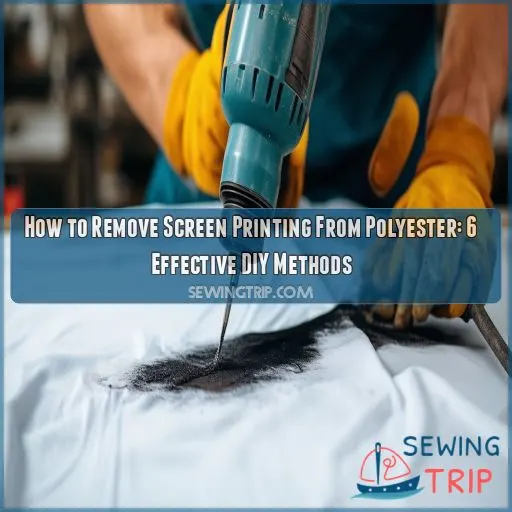 Countless polyester garments fall victim to unwanted screen printing every day. If you’re looking to remove screen printing from polyester, you’ve come to the right place.
Countless polyester garments fall victim to unwanted screen printing every day. If you’re looking to remove screen printing from polyester, you’ve come to the right place.
This guide will walk you through 6 effective DIY methods to liberate your fabric from stubborn designs. You’ll learn how to safely use solvents, apply heat, and employ gentle techniques to erase screen printing without damaging your polyester.
Table Of Contents
- Key Takeaways
- How to Remove Screen Printing From Polyester?
- Polyester Fabric and Screen Printing
- Using Acetone or Nail Polish Remover
- Applying Polyester-Safe Solutions
- Removal Techniques for Brand Logos
- Delicate Fabrics and Screen Printing Removal
- Precautions for Chemical Handling
- Testing Solvents on Polyester
- Washing Polyester Fabric After Solvent Use
- Heat Press and Screen Printing Removal
- Final Tips for Removing Screen Printing
- Frequently Asked Questions (FAQs)
- Conclusion
Key Takeaways
- Polyester’s as stubborn as a mule when it comes to screen printing, but don’t throw in the towel just yet! With a bit of elbow grease and the right technique, you’ll have that pesky print peeling off faster than you can say "acetone."
- Speaking of which, solvents are your new best friends in this ink-busting adventure. Just remember to treat them with respect – work in a well-ventilated area and gear up like you’re about to perform surgery. Safety first, fashion mavens!
- Feeling eco-conscious? Mother Nature’s got your back! Whip up a vinegar and baking soda paste that’ll have those prints running for the hills. It might take a bit longer, but hey, Rome wasn’t de-printed in a day, right?
- When all else fails, bring out the big guns – aka the heat press. It’s like giving your polyester a spa day, except instead of relaxing, it’s sweating off that unwanted ink. Just don’t crank it up too high, or you’ll end up with a polyester pancake!
How to Remove Screen Printing From Polyester?
To remove screen printing from polyester, you’ve got several effective options. Start by identifying the ink type, as this determines the best removal method.
For stubborn prints, acetone or nail polish remover can work wonders. Apply it to the back of the print with a cotton ball and gently rub in circular motions.
Alternatively, try polyester-safe solutions like rubbing alcohol, adhesive remover, or a vinegar and baking soda paste.
For brand logos, consider techniques like heat treatment or knife scraping for raised prints.
Always test your chosen method on a small, inconspicuous area first. With the right approach, you’ll be on your way to a print-free polyester garment in no time.
Polyester Fabric and Screen Printing
Screen printing on polyester fabric creates durable, high-quality designs that can withstand numerous washes. However, you might find yourself wanting to remove these prints for various reasons.
Polyester’s synthetic nature makes it resistant to many solvents, which can complicate the removal process. The screen printing ink used on polyester is specially formulated to adhere well to the fabric’s smooth surface, ensuring print quality and longevity. Over time, you may notice some fading, but complete removal often requires intervention.
Custom screen printing on polyester is popular for sportswear and promotional items due to its durability. When considering screen print removal, it’s crucial to understand the interaction between the polyester fabric and the ink.
Different solvents and techniques can be effective, but caution is necessary to preserve the fabric’s integrity. Let’s explore some methods to liberate your polyester garments from unwanted prints.
Using Acetone or Nail Polish Remover
Now that you understand the basics of polyester and screen printing, let’s dive into a powerful removal method: acetone or nail polish remover. These solvents can be your secret weapons against stubborn prints, but they come with risks.
Before you start, remember that acetone and nail polish remover fumes can be harmful. Work in a well-ventilated area and consider wearing a mask. Apply a small amount of the solvent to the back of the print using a cotton ball. Gently rub in circular motions, allowing the chemical to break down the ink. Be cautious, as excessive use can lead to polyester damage or fabric discoloration.
As you work, keep an eye out for any signs of skin irritation. If the print doesn’t budge, don’t force it. You might need to explore other options like heat press techniques or specialized plastisol removers for tougher jobs.
Applying Polyester-Safe Solutions
While acetone works well, you might prefer polyester-safe solutions for more delicate fabrics. These alternatives are gentler on your garment while still effectively removing screen printing. Here’s a list of safe solvents and methods to try:
- Rubbing alcohol: Apply to the print and gently scrub
- Adhesive remover: Ideal for tackling stubborn glue residue
- Vinegar and baking soda paste: Natural alternative for eco-conscious users
- Commercial print remover: Specifically designed for polyester fabrics
When blending solutions, always test on a small, hidden area first. Remember, polyester is more sensitive than cotton fabric, so handle chemicals with care. For vinyl prints, start with milder methods before escalating to stronger solvents. If you’re dealing with particularly delicate fabrics, consider alternative methods like heat application or professional removal services. Always prioritize fabric integrity and your safety when attempting DIY screen printing removal.
Removal Techniques for Brand Logos
When tackling brand logos on polyester, you’ll need to consider the ink type and color. Here’s a breakdown of effective removal techniques:
| Method | Best For | Effectiveness | Caution |
|---|---|---|---|
| Acetone | Dark inks | High | May damage fabric |
| Rubbing alcohol | Light colors | Moderate | Test first |
| Heat treatment | Heat transfer logos | Variable | Can melt polyester |
| Knife scraping | Raised prints | High | Risk of tearing |
| DTF print removers | Digital transfers | High | Follow instructions |
Start by testing your chosen method on a small, hidden area. For heat-sensitive logos, try ironing with a protective cloth. If you’re dealing with stubborn prints, combine methods for better results. Remember, some colors may be more resistant than others. Always prioritize fabric safety over complete removal. With patience and the right technique, you’ll liberate your polyester from unwanted logos, giving you control over your garment’s appearance.
Delicate Fabrics and Screen Printing Removal
While brand logos can be stubborn, delicate fabrics pose their own challenges when removing screen printing. You’ll need to tread carefully to avoid damaging these sensitive materials. Natural methods are your best bet, as they’re gentler on fragile fibers. Consider using a sugar scrub or a mixture of vinegar and baking soda to slowly break down the print. For vinyl or rubber prints, the iron and peel method can be effective, but watch out for heat sensitivities.
- Use a soft-bristled brush to minimize abrasion concerns
- Apply steam to loosen the print without harsh chemicals
- Test any method on an inconspicuous area first
Precautions for Chemical Handling
When handling chemicals to remove screen printing from polyester, you’re dealing with potentially hazardous substances. Safety should be your top priority. Here’s a quick guide to help you mitigate risks:
| Precaution | Purpose | Equipment |
|---|---|---|
| Ventilation | Prevent toxic fumes | Open windows, fans |
| Skin protection | Avoid chemical burns | Rubber gloves |
| Eye safety | Guard against splashes | Safety goggles |
| Spill control | Contain accidents | Absorbent materials |
Always work in a well-ventilated area to avoid inhaling fumes. Protect your skin with chemical-resistant gloves and wear safety goggles to shield your eyes. Keep a spill kit nearby for quick cleanup of any accidents. Remember, these chemicals can be harsh on both you and your polyester fabric. By taking these precautions, you’ll safely navigate the screen printing removal process while maintaining control over your environment. Don’t let fear of chemicals hold you back – master the art of safe handling and liberate your polyester from unwanted prints.
Testing Solvents on Polyester
Before diving into screen printing removal, it’s crucial to test solvents on your polyester fabric. You’ll want to ensure fabric compatibility and colorfastness to avoid any unwanted surprises.
Start by selecting an inconspicuous area, like an inside seam or hem. Apply a small amount of the solvent you’re planning to use and wait for a few minutes. Keep an eye out for any discoloration, fabric distortion, or unusual reactions. If you notice any changes, it’s best to try a different method.
Washing Polyester Fabric After Solvent Use
After testing solvents on your polyester fabric, it’s crucial to wash it properly. You’ve conquered the screen printing, but now it’s time to tackle those harsh chemical smells and any lingering residue. Don’t worry, you’re in control of this final step!
Start by rinsing the treated area thoroughly with cold water to remove any remaining chemicals. Then, wash your garment according to its care instructions. For delicate fabric considerations, use a gentle cycle and mild detergent. If you’re dealing with stubborn residue, pre-treat the area with a stain remover before washing.
Heat Press and Screen Printing Removal
Heat press removal can be an effective method for tackling stubborn screen prints on polyester. This technique works particularly well with plastisol and water-based inks. To begin, set your heat press to the appropriate temperature for polyester, typically around 300°F (149°C). Place a piece of parchment paper over the print and press for 10-15 seconds. The heat reactivates the ink, making it easier to peel off.
Here are some key points to remember:
- Always test colorfastness before applying heat to avoid damaging the fabric
- Use a scraper or old credit card to gently lift the softened ink
- For stubborn prints, repeat the process, increasing pressure slightly
If the heat press method doesn’t yield results, you might need to combine it with other screen printing removal techniques. Remember, different ink types may respond differently, so patience and experimentation are key to mastering this process.
Final Tips for Removing Screen Printing
As you wrap up your screen printing removal journey, keep these final tips in mind:
- Always prioritize solvent safety by working in a well-ventilated area and wearing protective gloves.
- Consider fabric sensitivity before applying any removal method, especially with delicate or vintage polyester items.
- Don’t underestimate home remedies like vinegar and baking soda for less stubborn prints.
- When in doubt, seek professional removal services to avoid damaging your garment.
Frequently Asked Questions (FAQs)
How do you remove screen print from 100% polyester?
You’ll need a solvent-based method for polyester. Apply acetone or a polyester-safe remover to the print’s back. Gently peel off the design. Test on a hidden area first. Wash the garment thoroughly afterward to remove any residue.
Can screen printing be removed?
Like peeling away layers of paint to reveal a hidden masterpiece, screen printing removal is possible. You can use solvents, heat, or mechanical methods to break down the ink. Test carefully on a small area first to avoid damaging your polyester fabric.
How to remove brand logo from polyester?
To remove a brand logo from polyester, you’ll need a solvent-based method. Apply acetone or a polyester-safe remover to the back of the fabric. Gently scrape off the logo with a soft brush. Always test on an inconspicuous area first.
How to remove fabric print from clothes?
You’ve got options to remove fabric prints from clothes. Try using heat and peeling, solvents like acetone, or gentle scrubbing with rubbing alcohol. Test on a hidden area first, and always prioritize fabric safety. Don’t forget protective gear!
Can screen printing be removed from polyester-cotton blends?
Ironically, you’d think blends would be easier to handle. You can remove screen printing from polyester-cotton blends using acetone, nail polish remover, or specialized solvents. Test a small area first, apply the solution, and gently scrape off the print.
How to remove old, cracked screen printing from polyester?
You’ll need to tackle old, cracked screen printing on polyester with care. Apply a polyester-safe solvent like acetone or nail polish remover. Gently scrub with a soft brush, then peel off the print. Rinse thoroughly and air dry.
Are there eco-friendly methods for removing screen printing?
While harsh chemicals strip prints, nature offers gentler solutions. You can use vinegar and baking soda, citrus oils, or even enzyme-based cleaners. These eco-friendly methods won’t harm the environment but may require more patience and elbow grease.
Can screen printing removal affect polyesters water-resistant properties?
Yes, screen printing removal can impact polyester’s water resistance. Harsh solvents may damage the fabric’s protective coating. You’ll want to use gentler methods or specialized polyester-safe removers to preserve the material’s water-repellent properties. Always test in an inconspicuous area first.
How to remove screen printing without damaging embroidery nearby?
To protect nearby embroidery, carefully apply a solvent-soaked cloth to the screen print’s edges. Gently peel away the print, working slowly to avoid contact with embroidered areas. Use a soft brush for residue removal, keeping the embroidery dry.
Conclusion
Just as a skilled artist can transform a blank canvas, you now possess the tools to remove screen printing from polyester. Armed with these six effective DIY methods, you’re ready to tackle unwanted designs with confidence.
Remember to always test your chosen technique on a small, inconspicuous area first. Whether you opt for solvents, heat, or gentle abrasion, you’ll find a method that suits your needs.
With patience and care, you’ll soon master how to remove screen printing from polyester, giving your garments a fresh start.

